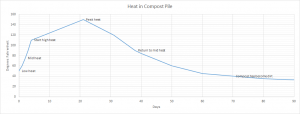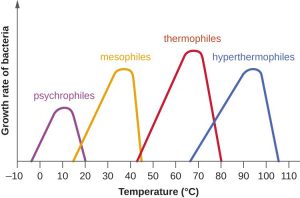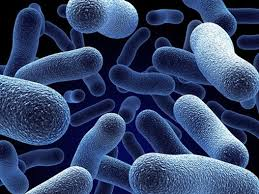Microorganisms:
The decomposers within the pile that are responsible for changing the chemistry of organic waste materials.
Aerobic Bacteria: The most important of these decomposers. Capable of consuming practically anything, they take in Carbon and Nitrogen to grow and reproduce, obtaining energy by oxidizing organic material. Require specific Oxygen concentrations of 5%, otherwise will become inactive or die, which can slow composition rate over 90%. They are also useful in that they excrete plant nutrients such as Nitrogen, Phosphorus, and Magnesium.
Types:
Psychrophilic bacteria: Work in the lowest temperature range, preferred range starting at 55° F but will work if the initial pile temperature is less than 70º F. Produce the least heat of any bacteria, but produce just enough to warm the pile enough for the next step of the composition process to occur, the introduction of:
Mesophilic bacteria: These bacteria rapidly decompose organic matter, producing acids, carbon dioxide and heat in the process. They can work within the temperature range between 70º to 100º F, but at the height of this they start dying off, or moving to the outermost edges of the pile which have not reached such high temperatures. Their exodus leaves room for:
Thermophilic bacteria: These thrive at the highest temperatures, working from 100 to 160º F. Their process moves fast, only sustainable for 3-5 days unless new material is constantly being added to the pile as they consume organic material quickly. Once the pile begins to cool once again, the Mesophilic bacteria take over once more, quickly consuming any remaining organic material with the help of other surviving organisms.
Anaerobic Bacteria: Take over when Aerobic Bacteria are inactive, producing useless organic acids and ammonia-like substances that contain unavailable nutrients and can even be toxic to plants. These bacteria are responsible for the bad smells produced by compost in their production of hydrogen sulfide, cadaverine, and putrescine.
Actinomycetes: A higher-form bacteria similar in structure to Fungi or Molds. They appear greyish, and work in the medium heat of the pile, much similar to the Mesophilic bacteria. These are responsible for breaking down the most resilient materials within the pile, like lignin, cellulose, starches, and proteins. As they break down organic matter they liberate carbon, nitrogen, and ammonia, making nutrients available within the created dirt. These bacteria are what produce the earthy, pleasant smell of compost, and become more obvious as the composting process goes on, forming large clusters within the later stages.
Fungi: Primitive plants, lacking a photosynthetic pigment, that can be single or multicellular creatures. Prefer cooler temperatures, and usually only take part in the process at the very end, breaking down cellulose and lignin, after faster acting bacteria have made inroads on them.
Macroorganisms:
Responsible for actually breaking down various organic items in compost physically by chewing, digesting, etc. in the latter stages of a composting cycle. These organisms’ excrement is further broken down by microorganisms and some of these serve as a food source for higher level consumers in this food chain.
Consumers: The macroorganisms in a compost pile can be separated into 3 different groups: 1st level consumers, 2nd level consumers, and 3rd level consumers.
-1st level consumers become food for the 2nd level consumers.
-2nd level consumers become food for 3rd level consumers.
This creates a complex food chain inside the compost pile that ultimately helps to further the process of decomposition.
Ants: These feed on a variety of materials including seeds, fungi, and other insects. Ants help create a more rich environment in the compost by moving around minerals like Phosphorus and Potassium.
Millipedes: Worm-like segmented insects that have many walking legs. These macroorganisms mainly help in the vegetation decomposition by feeding on organic greens.
Centipedes: Worm-like segmented insects with less walking legs that appear flat. Most feed on other consumers like spiders and insects.
Sow Bugs: Have a characteristic flat, oval body with 20 legs. They feed primarily decaying vegetation like rotting wood.
Springtails: These insects are small and vary in color from white to black. Most notably they have an incredible ability to jump. Most springtails prefer to feed on fungi and mold.
Earthworms are secondary consumers that are considered later compost immigrants and feed on the remains of earlier inhabitants in the compost. Earthworms can be used to recycle earlier organic materials that they then convert to vermicompost, a rich compost substance.
Beetles are tertiary consumers in compost. The most common beetles in compost are the rove beetle, ground beetle and feather-winged beetle. The feather-winged beetle eat fungi spores while most beetles, including the rove, eat spiders, mites, and other beetles.
Spiders are prey for the tertiary predators (ants, centipedes, beetles). Spiders are some of the many physical decomposers that tear up organic material into even smaller pieces. As we are all accustomed to, spiders have eight legs and generally feed on insects and flies. They can also help control garden pest in a compost garden.
Flies are secondary consumers and the prey for centipedes and spiders. Flies are ideal for transporting bacteria to all parts of the compost in the early cycles of your compost.
Snails and slugs are secondary consumers and food for centipedes. Snails have a shell on them while, slugs are basically the same, except shelless. Both are mollusks that eat organic material and help break down material in your compost, but if they reach the garden they can do great damage to crops.
Soil flatworms are small flattened carnivores that typically live in films of water inside the compost.
Here’s a fun game you can play to learn about composting: FUN GAME!!!!






